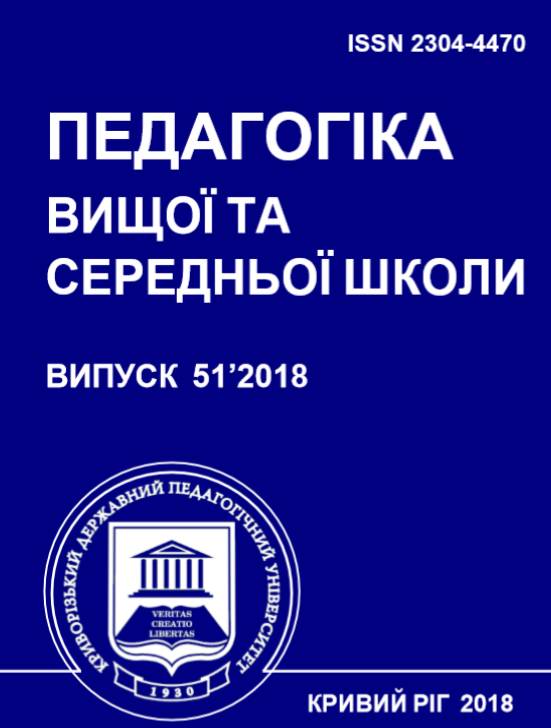The Potential of Using Google Expeditions and Google Lens Tools under STEM-education in Ukraine
DOI:
https://doi.org/10.31812/pedag.v51i0.3659Keywords:
augmented reality, Google Expeditions, Google Lens, STEM-approach of educationAbstract
Shapovalov Yе.B., Bilyk Zh.I., Atamas A.I., Shapovalov V.V. and Uchytel A.D. The Potential of Using Google Expeditions and Google Lens Tools under STEM-education in Ukraine.
The expediency of using the augmented reality in the case of using of STEM-education in Ukraine is shown. The features of the augmented reality and its classification are described. The possibilities of using the Google Expeditions and Google Lens as platforms of the augmented reality is analyzed. A comparison, analysis, synthesis, induction and deduction was carried out to study the potential of using augmented reality platforms in the educational process. Main characteristics of Google Expeditions and Google Lens are described. There determined that augmented reality tools can improve students motivation to learn and correspond to trends of STEM-education. However, there problems of using of augmented reality platforms, such as the lack of awareness of this system by teachers, the lack of guidance, the absence of
the Ukrainian-language interface and responding of educational programs of the Ministry of Education and Science of Ukraine. There proposed to involve methodical and pedagogical specialists to development of methodical provision of the tools of augmented reality.
Downloads
References
About Google Expeditions. Aquila Education. https://www.aquilaeducation.com/google-expeditions-kits (2017). Accessed 31 Jan 2018.
Akçayır, M., Akçayır, G.: Advantages and challenges associated with augmented reality for education: A systematic review of the literature. Educational Research Review. 20, 1–11 (2016), doi: 10.1016/j.edurev.2016.11.002 DOI: https://doi.org/10.1016/j.edurev.2016.11.002
Antonietti, A., Imperio, E., Rasi, C., Sacco, M.: Virtual reality and hypermedia in learning to use a turning lathe. Journal of Computer Assisted Learning. 17 (2), 142–155 (2001). doi: 10.1046/j.0266-4909.2001.00167.x DOI: https://doi.org/10.1046/j.0266-4909.2001.00167.x
Boyles, B.: Virtual Reality and Augmented Reality in Education. United States Military Academy. https://www.usma.edu/cfe/Literature/Boyles_17.pdf (2017). Accessed 31 Dec 2017.
Dede, C.: Planning for Neomillennial Learning Styles. EDUCAUSE Quarterly. 28 (1), 7–12 (2005).
Dopovnena realnist, abo AR-tekhnolohii (Augmented Reality, or AR-technology). The Future. http://thefuture.news/lessons/ua/ar (2018). Accessed 31 Jan 2018.
Google Lens. Wikipedia. https://en.wikipedia.org/wiki/Google_Lens (2018). Accessed 13 Jan 2018.
Hazlewood, A.: Virtual Reality and Augmented Reality. A practical guide: Turning smartphones into exciting learning tools. http://www.soccon.net.nz/2017/wp-content/uploads/2016/11/Aleisha-Hazlewood.pdf (2016). Accessed 25 Dec 2017.
Hussein, M., Nätterdal, C.: The Benefits of Virtual Reality in Education: A Comparison Study. Bachelor of Science Thesis in Software Engineering and Management, University of Gothenburg. https://gupea.ub.gu.se/bitstream/2077/39977/1/gupea_2077_39977_1.pdf (2015). Accessed 25 Dec 2017.
Ibáñez, M. B., Di Serio, A., Villarán, D., Delgado Kloos, C.: Experimenting with electromagnetism using augmented reality: Impact on flow student experience and educational effectiveness. Computers &
Education. 71, 1–13 (2014). doi: 10.1016/j.compedu.2013.09.004 DOI: https://doi.org/10.1016/j.compedu.2013.09.004
Kinateder, M., Ronchi, E., Nilsson, D., Kobes, M., Müller, M., Pauli, P., Mülberger, A.: Virtual Reality for Fire Evacuation Research. In: Krasuski, A., Rein, G. (eds.) Federated Conference on Computer Science
and Information Systems, vol. 2, pp. 313–321). IEEE — Institute of Electrical and Electronics Engineers Inc. (2014). doi: 10.15439/2014F94 DOI: https://doi.org/10.15439/2014F94
Lee, E. A.-L., Wong, K. W.: Learning with desktop virtual reality: Low spatial ability learners are more positively affected. Computers & Education. 79, 49–58 (2014). doi: 10.1016/j.compedu.2014.07.010 DOI: https://doi.org/10.1016/j.compedu.2014.07.010
Mala akademiia nauk Ukrainy: Virtualnyi STEM-tsentr Maloi akademii nauk Ukrainy (Virtual STEM-Center of the Junior Academy of Sciences of Ukraine). http://stemua.science (2018). Accessed 27 Jan 2018.
Martı́n-Gutiérrez, J., Fabiani, P., Benesova, W., Dolores Meneses, M., Mora, C. E.: Augmented reality to promote collaborative and autonomous learning in higher education. Computers in Human Behavior. 51 (B), 752–761 (2015). doi: 10.1016/j.chb.2014.11.093 DOI: https://doi.org/10.1016/j.chb.2014.11.093
Melnick, K.: Google Brings AR Into The Classroom With ‘Expeditions AR’ Program. VRScout. https://vrscout.com/news/google-expeditions-ar-program/ (2017). Accessed 13 Jan 2018.
Modlo, E. O., Echkalo, Yu. V., Semerikov, S. O., Tkachuk, V. V.: Vykorystannia tekhnolohii dopovnenoi realnosti u mobilnooriientovanomu seredovyshchi navchannia VNZ (Using technology of augmented reality in a mobile-based learning environment of the higher educational institution). Naukovi zapysky, Seriia: Problemy metodyky fizyko-matematychnoi i tekhnolohichnoi osvity. 11 (1), 93–100 (2017).
Osvitnii proekt “Na Urok”: Zhurnal “Na Urok” (The magazine “For the lesson”). https://naurok.com.ua (2018). Accessed 13 Jan 2018.
Pilgrim, J. M., Pilgrim, J.: The Use of Virtual Reality Tools in the Reading-Language Arts Classroom. Texas Journal of Literacy Education. 4 (2), 90–97 (2016).
Potkonjak, V., Gardner, M., Callaghan, V., Mattila, P., Guetl, C., Petrović, V. M., Jovanović, K.: Virtual laboratories for education in science, technology, and engineering: A review. Computers & Education.
(C), 309–327 (2016). doi: 10.1016/j.compedu.2016.02.002 DOI: https://doi.org/10.1016/j.compedu.2016.02.002
Sala, N.: Applications of Virtual Reality Technologies in Architecture and in Engineering. International Journal of Space Technology Management and Innovation. 3 (2), 78–88 (2013). doi: 10.4018/ijstmi.2013070104 DOI: https://doi.org/10.4018/ijstmi.2013070104
Shapovalov, V. B., Shapovalov, Ye. B., Atamas, A. I, Bilyk, Zh. I.: Informatsiini ontolohichni instrumenty dlia zabezpechennia doslidnytskoho pidkhodu v STEM-navchanni (Information ontological tools to provide a research approach in STEM-education). In: Proccedings of the 10th International Scientific and Practical Conference on Gifted children — the intellectual potential of the state, Chornomorsk, 3–10 July 2017, pp. 366–371 (2017).
Wylie, J.: Google Expeditions: Lesson Ideas & Support for Schools. Owlcation. https://owlcation.com/academia/Google-Expeditions-Help-Support-for-Schools (2016). Accessed 29 Dec 2017.
Youngblut, C.: Educational Uses of Virtual Reality Technology. Institute for Defense Analyses, Alexandria (1998).
Zantua, L. S. O.: Utilization of Virtual Reality Content in Grade 6 Social Studies Using Affordable Virtual Reality Technology. Asia Pacific Journal of Multidisciplinary Research. 5 (2), 1–10 (2017).
Downloads
Published
Issue
Section
License
Copyright (c) 2018 Євгеній Шаповалов, Жанна Білик, Артем Атамась, Олександр Учитель

This work is licensed under a Creative Commons Attribution 4.0 International License.




